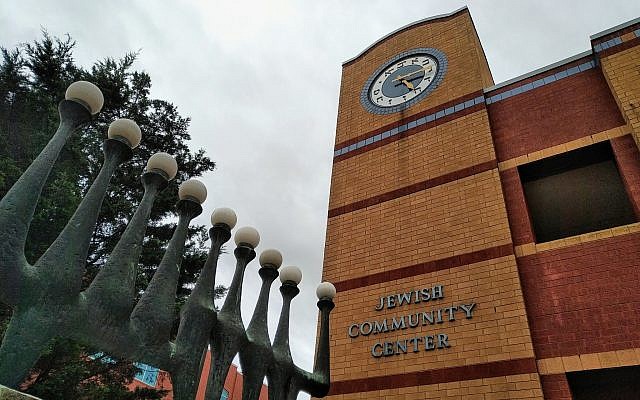The Pittsburgh synagogue shooter considered attacking both the South Hills and Squirrel Hill Jewish Community Centers, as well as an unnamed prominent Jewish person in Cleveland, before ultimately deciding to focus on Congregation Dor Hadash and the Tree of Life building.
On the morning of the attack, Oct. 27, 2018, Robert Bowers first drove by the Tree of Life building, noting that he could see five people through the front window, before continuing to the JCC in Squirrel Hill, ruling it out as a target because of its proximity to a police station. He then returned to the synagogue.
He parked in a handicapped spot, a detail he considered humorous, and then entered the building and began shooting at everyone he saw.
The new revelations were made during expert testimony Thursday, the fourth day of the trial’s second phase — the penalty eligibility phase — focusing on Bowers’ thoughts as recorded by Richard Rogers, a forensic psychologist and professor of psychology at the University of North Texas.
Rogers spent nearly 20 hours evaluating Bowers in September and November. He said the shooter believed that he was a warrior deserving of medals and parades and that white people were being attacked by Jewish people. He repeatedly referred to the day of the shooting as “attack day.”
“He tried not to express this very much, but he actually felt hurt that there was no parade for him for his warrior-like behavior,” Rogers said. “He was proud of it. He felt he had done something that, in his mind, might be seen as heroic.”
Rogers performed a variety of psychological tests on the defendant to determine the state of his mental health and whether he was faking or exaggerating symptoms. The results showed that the defendant had extreme delusions, hostility and felt persecuted by Jewish people, and that his answers were highly consistent with genuine responding. The timeline of his symptoms is vague because the defendant is a “poor historian,” according to Rogers.
“It was clear that by April, perhaps before April of 2018, that he clearly manifested symptoms of schizophrenia,” Rogers said.
Rogers also testified that the defendant did not experience hallucinations, contradicting the testimony of neurologist Siddhartha Nadkarni, who testified for the defense on Wednesday.
The defendant’s attorneys are hoping to convince the jury that his mental illness prevented him from forming the requisite intent to quality for capital punishment.
On cross-examination, prosecutor Eric Olshan combed through Rogers’ notes from his interviews with the defendant, many of which were not included in Rogers’ official report.
Rogers’ notes revealed that the defendant said he had three goals in mind: to kill Jewish people, whom he believed were committing genocide; to scare other Jewish people to dissuade them from committing genocide; and to encourage others to join in the killing.
By April 2018, the defendant began to consider potential attack targets, according to Rogers’ notes, including the Squirrel Hill and South Hills JCCs, before deciding on the Tree of Life building and Dor Hadash. He also considered committing the massacre a week earlier, on Oct. 20, and even looked at the synagogue’s schedule. He briefly hesitated at the thought of killing children before deciding that “a Jew is a Jew is a Jew,” Rogers notes showed.
The defendant also said he considered using gas dropped into a building and chaining the doors so people couldn’t get out, before ruling out this idea as impractical.
During the attack, the defendant hid upstairs and spotted two women standing by a BMW in the parking lot. He decided not to shoot them because it would reveal his location to the police. He purposefully used bullets manufactured in Israel to send a message, according to Rogers.
After the shooting, the defendant expressed disappointment that he had not killed more than the 11 Jews. He also referred to that number as a “Yiddish dozen,” and smirked when describing how he shot two worshippers near ovens, a detail he found ironic.
Because of scheduling, Rogers’ testimony was interrupted to allow for the prosecution to call Michael Williams, a corrections officer at Butler County Prison, where the defendant has been incarcerated.
Williams testified about the defendant’s demeanor and behavior in prison. He explained that the dye in the red jumpsuits that prisoners wear often rubs off and dyes walls and prison bracelets. The day before, defense expert Nadkarni testified the defendant exhibited a delusion in which ink from his clothing was entering his body and leeching out of his skin into his prison bracelet, dyeing it red.
Earlier this month, the jury found Bowers guilty on all 63 federal counts he faced. On Oct. 27, 2018, he murdered Joyce Fienberg, Richard Gottfried, Rose Mallinger, Jerry Rabinowitz, David Rosenthal, Cecil Rosenthal, Bernice Simon, Sylvan Simon, Dan Stein, Irving Younger and Melvin Wax.
Rogers’ testimony will continue on Friday, Day 5 of the second phase of the trial.
Related story: Resources are available to ease trauma during synagogue shooting trial.
This story is part of ongoing coverage of the Pittsburgh synagogue shooting trial by the Pittsburgh Jewish Chronicle and the Pittsburgh Union Progress in a collaboration supported by funding from the Pittsburgh Media Partnership.




